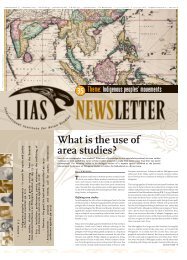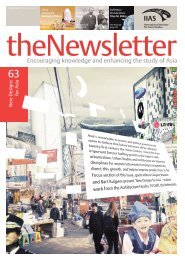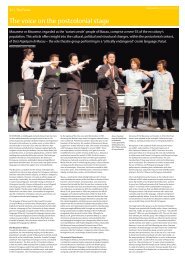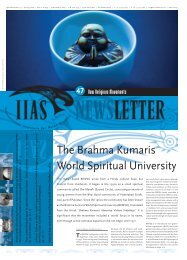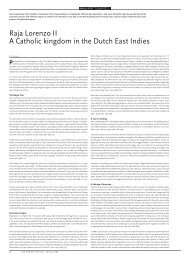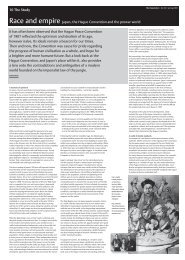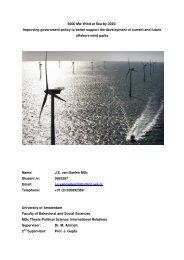Asia's Colonial Photographies
Asia's Colonial Photographies
Asia's Colonial Photographies
You also want an ePaper? Increase the reach of your titles
YUMPU automatically turns print PDFs into web optimized ePapers that Google loves.
Asia’s <strong>Colonial</strong> <strong>Photographies</strong><br />
Vivan Sundaram, “Remembering the Past,<br />
Looking to the Future”, 2001.<br />
Courtesy of the Artist & SEPIA International.<br />
Photography in India<br />
Photography was first introduced to India in 1840, only a year after the announcements of the daguerreotype and calotype processes<br />
in France and England. The fragility of this early material, the uniqueness of the daguerreotype and the harshness of the Indian<br />
climate mean that photographs from this time are scarce, leaving us with a fragmented picture of the development of the medium.<br />
Sophie Gordon<br />
Initially, commercial studios were<br />
established in cities such as Calcutta,<br />
where an ever-increasing clientele could<br />
be relied upon to keep up a demand for<br />
portraits. Some amateurs also brought<br />
cameras to India; some of the earliest<br />
surviving photographs from India are in<br />
a family album, now in the Getty Museum,<br />
containing views taken in Nainital,<br />
Bareilly and Kanpur during the mid-<br />
1840s (Fig.1). Around the same time,<br />
the French daguerreotypist Jules Itier<br />
(1802-77) passed through India, whilst<br />
engaged in a treaty negotiation with<br />
China. A handful of his views of South<br />
India still survive today in a number<br />
of collections. The extremely small<br />
amount of material that has survived<br />
from the 1840s must represent only a<br />
fraction of the photographic activity that<br />
took place.<br />
The <strong>Colonial</strong> Contribution<br />
This lack of material from the 1840s<br />
makes the story relatively straightforward<br />
to tell in its early years. After 1850,<br />
with the use of the camera spreading<br />
across the subcontinent, things get a little<br />
more complicated. The number and<br />
type of photographers at work increases<br />
dramatically within the space of a few<br />
years. Their output ranges from studio<br />
portraits to ethnographic documentation,<br />
from picturesque landscapes to<br />
documentary records of architecture,<br />
works of art and the natural history of<br />
India. The history of photography in<br />
India has, over the last quarter of a century,<br />
been told largely from the perspective<br />
of a handful of colonial collections,<br />
in particular the India Office Collection,<br />
now housed at the British Library in<br />
London. Publications by British Library<br />
curators, including Ray Desmond ‘s Victorian<br />
India in Focus (London, 1982) and<br />
John Falconer ‘s A Shifting Focus: Photography<br />
in India 1850-1900 (London,<br />
1995), have been influential in establishing<br />
significant photographers and<br />
events, while emphasising the importance<br />
of British documentary work.<br />
This colonial dominance is inevitable,<br />
for although the photographs in the<br />
India Office Collection combine to create<br />
an extraordinary collection of around<br />
250,000 items containing the work of<br />
hundreds of photographers, it represents<br />
what successive colonial administrators<br />
believed to be worth collecting<br />
and preserving, rather than being truly<br />
representative of photography in India.<br />
In particular the collection contains the<br />
photographs amassed by the Archaeological<br />
Survey of India, the official body<br />
set up by the British administration in<br />
1870 to identify and preserve India‘s<br />
architectural and archaeological heritage.<br />
This collection alone consists of<br />
37,781 prints, according to the online<br />
catalogue.(Fig.2)<br />
The development of ‘photography in<br />
India’ as a field of research has taken<br />
place within the wider context of the<br />
growth of the history of photography as<br />
a subject of serious investigation. This is<br />
evident through the creation of separate<br />
photography departments in museums,<br />
libraries and archives (the Museum of<br />
Modern Art in New York established<br />
a photography department relatively<br />
early in 1940, but many departments in<br />
European institutions were not created<br />
until the late 1960s and early 1970s)<br />
and, hand-in-hand with this, the development<br />
of a commercial market for<br />
buying and selling photographs. With<br />
museums focusing on the aesthetic<br />
qualities of photography at the expense<br />
of its social history and meaning, the<br />
work of a handful of photographers was<br />
identified and promoted at the expense<br />
of a greater understanding of the medium.<br />
From India, both Linnaeus Tripe<br />
(1822-1902) and Dr John Murray (1809-<br />
1898) are frequently cited as the most<br />
accomplished masters of the art, and to<br />
a lesser extent, Samuel Bourne (1834-<br />
1912). The work of these British photographers<br />
fits the European paradigm for<br />
successful, aesthetically-pleasing compositions<br />
and the landscapes of Bourne<br />
in particular are composed according to<br />
the demands of the Picturesque ideal.<br />
(Figs.3 & 4)<br />
There is some tension within the field<br />
between scholars from South Asian<br />
departments who concentrate exclusively<br />
on Indian photography within an<br />
Indian context but who know little about<br />
the broader history of photography, and<br />
those who work regularly with a wider<br />
range of photographic images, such as<br />
curators and photography dealers, but<br />
who generally know little about India.<br />
This debate can be boiled down to ‘context<br />
versus aesthetics’ and at present it<br />
shows no signs of abating. Some, however,<br />
have successfully engaged with<br />
different approaches and aspects of the<br />
work. Maria Antonella Pelizzari‘s publication<br />
Traces of India: Photography, Architecture<br />
and the Politics of Representation,<br />
1850-1900 (Montreal, 2004) contains<br />
contributions from a variety of scholars<br />
of different backgrounds, discussing a<br />
range of meanings and interpretations<br />
for architectural photography.<br />
The Private Collector<br />
The growth of the market and the role of<br />
the private collector have done much to<br />
stimulate the field into broadening and<br />
embracing new avenues for research.<br />
Each individual collector inevitably<br />
brings a unique set of criteria for making<br />
acquisitions. Indian collectors in<br />
particular come with ideas that differ<br />
greatly, in the most positive way, from<br />
those of Western museums. This usually<br />
ranges between a desire to preserve<br />
India‘s photographs because of the<br />
richness and beauty of the medium, to<br />
ensuring that the information contained<br />
within the images such as records of<br />
events and fast-disappearing buildings<br />
is not only saved but made available and<br />
used in the many conservation projects<br />
now establishing themselves in India.<br />
The Alkazi Collection, for example, has<br />
embraced many of these approaches.<br />
The collection acquires the acknowl-<br />
1 0<br />
I I A S N e w s l e t t e r | # 4 4 | S u m m e r 2 0 0 7
Asia’s <strong>Colonial</strong> <strong>Photographies</strong><br />
edged masters of photography as well<br />
as attempting to expand this category<br />
through promoting the work of other<br />
accomplished artists such as John<br />
Edward Saché (1824-1882) 1 . It is also<br />
creating an archive of work that represents<br />
local traditions and practices, for<br />
example, painted photographs 2 , collage<br />
and montage work, and material from<br />
studios working for the independent<br />
princely states as well as for middleclass<br />
Indian families. Scholars such<br />
as Christopher Pinney and Malavika<br />
Karlekar have recently worked on this<br />
type of material, presenting new lines<br />
of thought and opening up new and<br />
unexplored collections in an academic<br />
field that has, since the 1990s, been in<br />
danger of stagnating under Foucauldian<br />
approaches to (colonial) discourse and<br />
power. (Fig.5)<br />
Karlekar‘s work has also broken the<br />
artificial chronological boundaries that<br />
have arisen in the field, wherein early<br />
photography up to c. 1911 is considered<br />
the domain of the historian, early 20th<br />
century photography that of the anthropologist,<br />
and photography after 1947<br />
belongs to the modern art world. These<br />
categories, coming from equally artificial<br />
timeframes imposed in Western art<br />
history and other humanities subjects,<br />
do not take into account local practices.<br />
This has resulted in large quantities<br />
of material, particularly from the early<br />
to mid-20th century, being ignored.<br />
For example, although photographic<br />
journals from the 19th century have<br />
been fully examined, the journals of<br />
the Photographic Society of India that<br />
were published in the 1920s are rarely<br />
referenced. Work that is typically reproduced<br />
and discussed in the journals<br />
was stylistically heavily influenced by<br />
Pictorialism - consciously drawing on<br />
the conventions of Western academic<br />
painting and emphasising the position<br />
of the photographer as Artist – at<br />
a time when Europe was rejecting the<br />
art photograph in favour of work that<br />
challenged existing conventions and<br />
traditional definitions. This ‘soft pictorialism’<br />
that was practised in India was<br />
enormously popular for many years, yet<br />
it remains an unexplored avenue within<br />
the field.<br />
These divisions and omissions have<br />
also lead to modern and contemporary<br />
photographic practice in India<br />
being divorced from its own history, as<br />
Indian artists look almost exclusively<br />
to Euro-American photographers for<br />
precedence. This has some parallels<br />
with past and current debates within the<br />
contemporary art field in India, leading<br />
in particular to questions over identity<br />
that have been raised by artists as well<br />
as by critics.<br />
Photographic Connections<br />
The last few years have been remarkably<br />
fruitful with more publications<br />
and exhibitions tackling diverse aspects<br />
of this extraordinarily rich subject. The<br />
efforts of Sabeena Gadihoke to explore<br />
the work of Homai Vyarawalla (b.1913),<br />
which began in Gadihoke ‘s documentary<br />
film Three Women and a Camera<br />
(1989), have culminated in a substantial<br />
publication that presents Vyarawalla‘s<br />
entire output, while focusing in depth<br />
on her work as a photojournalist. There<br />
has also been a publication dealing with<br />
fig. 1: One of the earliest<br />
surviving images<br />
of India.<br />
Unknown amateur,<br />
Street scene in a town<br />
in Uttar Pradesh. Salt<br />
print, c 1843-5.<br />
(c) Christies Images Ltd.<br />
2007<br />
fig. 2: William Henry<br />
Pigou, Shiva Temple<br />
at Chaudanpur, in<br />
Karnataka. Albumen<br />
print, c. 1857. From<br />
the Archaeological<br />
Survey of India Collections.<br />
(c) The British Library,<br />
Photo 1000/9(1043<br />
fig. 3: Dr. John Murray,<br />
Agra, Taj Mahal.<br />
Salt print, c.1858.<br />
The Royal Collection<br />
(c)2007 HM Queen Elizabeth<br />
II. (RCIN 2701440)<br />
fig. 4: Samuel Bourne.<br />
Kanpur, The Memorial<br />
Well. albumen<br />
print, 1865.<br />
The Royal Collection<br />
(c) 2007 HM Queen<br />
Elizabeth II<br />
(RCIN 20701748).<br />
fig. 5: Unknown<br />
Studio, “Raj Sri<br />
Kishore and Raj Sri<br />
Hari Singh, against a<br />
European backdrop”,<br />
photomontage,<br />
gelatin silver print,<br />
watercolour, & gold,<br />
c. 1900.<br />
Courtesy of The<br />
Alkazi Collection of<br />
Photography.<br />
fig. 6: Unknown photographer,<br />
possibly<br />
Nicholas & Co. Kottayam,<br />
Syrian Church<br />
with the priest Mar<br />
Dionysius standing on<br />
the stone. From Lady<br />
Napier’s Tour of Travancore<br />
Album. Albumen<br />
print, c. 1868.<br />
The Royal Collection<br />
(c) 2007 HM Queen<br />
Elizabeth II<br />
(RCIN 2701525).<br />
the Lafayette studio‘s portraits of Indian<br />
rulers, all of which were taken in Britain<br />
in the early 20th century. The collection<br />
of glass negatives from the Lafayette<br />
studio is now split between the Victoria<br />
and Albert Museum and the National<br />
Portrait Gallery in London, the latter<br />
receiving the post-1925 material.<br />
This work raises interesting questions<br />
not only over representation and identity<br />
when in the home of the Raj, but also<br />
over photographic links between India<br />
and Britain. Material was frequently<br />
sent from India to Britain, through diplomatic<br />
and official channels, in order<br />
to pass on information about the country.<br />
The Royal Collection in Britain contains<br />
several groups of photographs that<br />
were sent to Queen Victoria, Empress<br />
of India for just this purpose. Amongst<br />
these is a particularly unusual group of<br />
views of Travancore (modern-day south<br />
Kerala), sent to the Queen by Lady Napier,<br />
wife of the Governor of Madras, who<br />
toured the region in 1868. The photographs<br />
were accompanied by lengthy<br />
descriptions by Lady Napier, recounting<br />
everything that was encountered on<br />
tour. (Fig.6)<br />
Some photographers sent their work<br />
for inclusion in exhibitions in Britain;<br />
for example, Murray exhibited a view<br />
of the Taj Mahal in the London Photographic<br />
Society exhibition in 1858, and<br />
Captain Henry Dixon showed views of<br />
Udayagiri (in Orissa) in the 1861 Architectural<br />
Photographic Association show,<br />
also in London. British families often<br />
purchased photographs and compiled<br />
albums as souvenirs; later they sent<br />
home postcards, showing monuments<br />
such as the Taj Mahal or the site of the<br />
Kanpur massacre.<br />
The flow of information was not just<br />
one-way, however. Portraits taken in<br />
the Lafayette, Vandyk or Bassano studios<br />
in Britain frequently found their<br />
way to India. Even from the 1850s,<br />
photographs by leading British photographers<br />
were exhibited in exhibitions<br />
and were circulated at photographic<br />
society meetings. Extracts from several<br />
European photographic journals were<br />
published in India, where everything<br />
from reviews of the latest exhibitions<br />
to how to compose the best landscape<br />
views was discussed. The photographic<br />
societies - the first being established in<br />
1854 in Bombay, followed by societies<br />
- in 1856 in Calcutta and Madras - were<br />
central in the early decades to establishing<br />
information networks through their<br />
meetings and journals and encouraging<br />
an exchange of queries and responses<br />
from the members.<br />
Today in India, contemporary photographic<br />
practice faces the same dilemmas<br />
as it does anywhere else in the<br />
world. With the recent re-branding of<br />
photography as ‘contemporary art’, we<br />
are now in danger of establishing a twotiered<br />
system in which anything not<br />
deemed worthy of the contemporary art<br />
description is regarded as second-class.<br />
Those photographers, or ‘camera artists’,<br />
promoted to an international level<br />
have their work displayed in major galleries<br />
and museums such as Tate Modern,<br />
and their prints are sold in contemporary<br />
art auctions at Sotheby‘s and<br />
Christie‘s (rather than in photography<br />
auctions). It is interesting that one of<br />
the few Indian artists working with photography<br />
at this level is Vivan Sundaram<br />
(b.1943), yet he is not a photographer.<br />
He employs photographs by Umrao<br />
Sher-gil (1870-1954) and then manipulates<br />
them digitally to incorporate<br />
further images of Umrao ‘s daughter,<br />
Amrita Sher-gil, one of India’s foremost<br />
twentieth century painters. Sundaram is<br />
Amrita ‘s nephew. (main image)<br />
What is remarkable about Sundaram’s’<br />
series of photographs titled Re-take of<br />
Amrita (2001-2) is that, while sometimes<br />
beautiful and at other times<br />
deeply unsettling, it engages with photographers<br />
and artists, as well as with<br />
critics and the public, over issues concerning<br />
truth, identity and the nature<br />
of the medium. These concerns were<br />
central to debates over photography in<br />
the 1850s and remain so today. <<br />
Suggested further reading<br />
- Desmond, Ray. 1982 Victorian India in<br />
Focus: A Selection of Early Photographs<br />
from the Collection in the India Office<br />
Library and Records. HMSO: London<br />
- Gadihoke, Sabeena. 2006 India in Focus.<br />
Camera Chronicles of Homai Vyarawalla.<br />
Parzo Foundation & Mapin Publishing:<br />
New Delhi<br />
- Falconer, John. 1995 A Shifting Focus: Photography<br />
in India 1850-1900. The British<br />
Council: London<br />
- Gordon, Sophie. 2004 Uncovering India:<br />
Studies of Nineteenth-Century Indian<br />
Photography , History of Photography 28:2,<br />
180-190<br />
- Harris, Russell.2005 The Full Feature. The<br />
Lafayette Studio and Princely India. Roli<br />
Books: New Delhi, 2005.<br />
- Karlekar, Malavika, ed. 2006 Visualizing<br />
Indian Women 1875-1947. Oxford University<br />
Press: New Delhi<br />
- Pelizzari, Maria Antonella, ed. 2004 Traces<br />
of India: Photography, Architecture, and the<br />
Politics of Representation, 1850-1900. Canadian<br />
Centre for Architecture: Montreal<br />
- Pinney, Christopher. 1997 Camera Indica:<br />
The Social Life of Indian Photographs. Reaktion<br />
Press: London<br />
- Sundaram, Vivan. 2006 Re-take of Amrita.<br />
Sepia International and The Alkazi Collection:<br />
New York<br />
- Thomas, G. 1981 History of Photography:<br />
India 1840-1940. Andhra Pradesh State<br />
Academi of Photography: Pondicherry<br />
www.bl.uk<br />
www.sepia.org<br />
Notes<br />
1 Exhibition held at Sepia International Inc.,<br />
New York, 22 November 2002 - 11 January<br />
2003.<br />
2 Exhibition held at Sepia International Inc.,<br />
New York, 10 May 12 July 2003.<br />
Sophie Gordon<br />
Curator, Royal Photograph Collection<br />
sophie.gordon@royalcollection.org.uk<br />
I I A S N e w s l e t t e r | # 4 4 | S u m m e r 2 0 0 7 1 1



